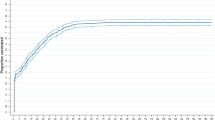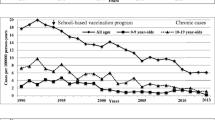Abstract
Background: Vancouver-Richmond Health Board has the highest reported rate of hepatitis B in Canada, including an annual average of 25 cases in children under 12 years of age, based on reports from 1994–1997 inclusive. The current provincial adolescent grade-six hepatitis B immunization program does not protect against childhood infection. The regional health board implemented universal infant hepatitis B immunization in September 1998.
Method: Immunization coverage data were obtained on a random sample of 191 infants born in March 1999 one year after initiation of the program.
Results: By eight months of age, 97.9% of children had received some vaccinations. 73.8% of infants had received three doses of hepatitis B vaccine and 12.6% had received two doses. In comparison, 89% had received three doses and 7.9% two doses of DPTPHib vaccine. 13.1% of infants had not received any hepatitis B vaccine. For a majority (67%) of these children, their physician’s lack of awareness or lack of acceptance of the program constituted the reason for no hepatitis B vaccine uptake. Only one parent cited adverse publicity as the reason for refusing vaccination.
Interpretation: This survey reveals a successful first year of the program without harm to the pre-existing childhood vaccination programs. Hepatitis B vaccine uptake can be improved by increased awareness among physicians and parents.
Résumé
Contexte: Le conseil de santé de Vancouver-Richmond déclare le plus haut taux d’hépatite B au Canada, notamment une moyenne annuelle de 25 cas chez les enfants de moins de 12 ans selon les rapports de 1994 à 1997 inclusivement. Le programme de vaccination contre l’hépatite B en vigueur dans la province pour les adolescents de sixième année n’offre aucune protection contre l’infection durant l’enfance. Le conseil de santé régional a mis en oeuvre un programme universel de vaccination des nourrissons contre l’hépatite B en septembre 1998.
Méthode: Obtention de données sur la couverture vaccinale à partir d’un échantillon aléatoire de 191 nourrissons nés en mars 1999, un an après le début du programme.
Résultats: À huit mois, 97,9 % des enfants avaient reçu certains vaccins: 73,8 % des nourrissons avaient reçu trois doses du vaccin contre l’hépatite B, et 12,6 % en avaient reçu deux doses (à titre de comparaison, 89 % avaient reçu trois doses et 7,9 % avaient reçu deux doses du vaccin contre DPTP-HIB); 13,1 % des nourrissons n’avaient pas été vaccinés contre l’hépatite B. Pour la majorité (67 %) des enfants non vaccinés contre l’hépatite B, c’est le médecin qui ignorait l’existance du programme ou n’y adhérait pas. Un seul parent a dit avoir refusé le vaccin parce qu’il avait mauvaise presse.
Interprétation: Le sondage indique que la première année du programme a été fructueuse et n’a causé aucun tort aux programmes préexistants de vaccination des enfants. L’acceptation du vaccin contre l’hépatite B peut être améliorée par une sensibilisation accrue des médecins et des parents.
Similar content being viewed by others
References
Canadian Pediatric Society Statement. Hepatitis B in Canada: The case for universal vaccination. CMAJ 1992;146(1):25–28.
Immunization Practices Advisory Committee (ACIP). Hepatitis B virus: A comprehensive strategy for eliminating transmission in the United States through universal childhood vaccination. MMWR 1991;40;RR-13-1:1–25.
Huang K, Lin S. Nationwide vaccination: A success story in Taiwan. Vaccine 2000;18(S1):S35–S38.
Safary A, Beck J. Vaccination against hepatitis B: Current challenges for Asian countries and future directions. J Gastroenterology 2000;15(4):396–401.
Krahn M, Detsky, AS. Should Canada and the United States universally vaccinate infants against hepatitis B? A cost-effectiveness analysis. Medical Decision Making 1993;13(1):4–20.
Scheifele D, LaJeunesse C, Marty K, Chen L. Comparison of physicians and health department staff as timely providers of childhood vaccines. BC Med J 1996;38(7):372–74.
Scheifele D, Lightle G, LaJeunesse C, Garry J, Addison J, Price P. Timeliness of uptake of early childhood immunizations–Richmond, BC. BC Health and Disease Surveillance 1996;5(2/3):14–17.
Health 2000. Report on the Health of the Population of Vancouver/Richmond. VRHB. www.vcn.bc.ca/vrhb/Down_Loads/Health_2000
Hurie MB, Mast EE, Davis, JP. Horizontal transmission of hepatitis B virus infection to United States-born children of Hmong refugees. Pediatrics 1992;89:269–73.
Franks AL, Berg CJ, Kane MA, Browne BB, Sikes RK, Elsea WR, Burton, AH. Hepatitis B virus infection among children born in the United States to Southeast Asian refugees. N Engl J Med 1989;321:1301–5.
Marsano LS, West DJ, Chan I, Hesley TM, Cos J, Hackworth V, Greenberg, RN. A two-dose hepatitis B vaccine regimen: Proof of priming and memory responses in young adults. Vaccine 1998;16:624–29.
West DJ, Calandra, GB. Vaccine induced immunologic memory for hepatitis B surface antigen: Implications for policy on booster vaccination. Vaccine 1996;14(11):1019–27.
Author information
Authors and Affiliations
Corresponding author
Rights and permissions
About this article
Cite this article
Dawar, M., Dobson, S., Kallos, A. et al. Measuring Hepatitis B Uptake in a New Universal Infant Program. Can J Public Health 93, 281–284 (2002). https://doi.org/10.1007/BF03405017
Received:
Accepted:
Published:
Issue Date:
DOI: https://doi.org/10.1007/BF03405017




